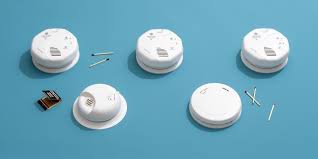Smoke detection is a critical component of fire safety systems in homes, offices, and public buildings. The importance of smoke detection cannot be overstated, as it can mean the difference between life and death in the event of a fire.
Smoke detectors work by detecting the presence of smoke particles in the air. They are designed to trigger an alarm when smoke is detected, alerting occupants to the potential danger and enabling them to evacuate the building quickly and safely.
There are two types of smoke detectors: ionization and photoelectric. Ionization detectors use a small amount of radioactive material to ionize the air inside the detector. When smoke enters the detector, it disrupts this ionization process, triggering an alarm. Photoelectric detectors use a beam of light that is aimed away from a sensor. When smoke enters the detector, it scatters the light beam onto the sensor, triggering an alarm.
Both types of detectors have their advantages and disadvantages. Ionization detectors are better at detecting fast-burning fires with lots of flames, while photoelectric detectors are better at detecting slow-burning fires with lots of smoke.
It’s important to note that smoke detectors should be installed in every room where people sleep, as well as in hallways outside sleeping areas. They should also be installed on every level of a building, including basements and attics.
In addition to installing smoke detectors, it’s also important to test them regularly to ensure they are working properly. This can be done by pressing the “test” button on the detector itself or using a canister of simulated smoke designed for testing purposes.
Finally, it’s important to replace batteries in smoke detectors regularly to ensure they remain operational. Many newer models have long-lasting batteries that can last up to 10 years without needing replacement.
In conclusion, smoke detection is an essential component of fire safety systems that can save lives in the event of a fire. By installing and maintaining smoke detectors in homes and public buildings, we can help ensure the safety of ourselves and those around us.
9 Essential Tips for Smoke Detection and Home Safety
- Install smoke detectors on every level of your home and in each bedroom.
- Test smoke detectors monthly to ensure they are working properly.
- Replace the batteries in your smoke detectors at least twice a year or as recommended by the manufacturer.
- Choose a type of detector that is best suited for your home, such as ionization, photoelectric, or dual sensor detectors.
- Clean dust and debris from smoke detector covers regularly to keep them functioning properly.
- Connect all of the smoke alarms in your home so that when one goes off, they all do simultaneously for maximum alertness and safety coverage throughout the house
- Never disable a smoke alarm even if it is going off while you are cooking; instead, open windows or turn on fans to help clear out any lingering smoke particles from the air quickly
- Make sure everyone in your household knows what sound each type of alarm makes and what to do when one goes off (such as leaving immediately)
- Have an evacuation plan set up with two exits from every room in case of emergency
Install smoke detectors on every level of your home and in each bedroom.
Installing smoke detectors on every level of your home and in each bedroom is a crucial step in ensuring the safety of you and your loved ones. Smoke detectors are designed to detect the presence of smoke particles in the air and trigger an alarm to alert occupants of potential danger.
Having smoke detectors on every level of your home ensures that any potential fire can be detected quickly, no matter where it starts. In addition, having a smoke detector in each bedroom is important because it can provide early warning if a fire starts while you are asleep.
It’s also important to note that smoke detectors should be installed properly and tested regularly to ensure they are working correctly. This means following manufacturer instructions for placement, testing the batteries at least once a month, and replacing batteries at least once a year.
By taking these simple steps, you can help protect yourself and your family from the dangers of fire. Don’t wait until it’s too late – install smoke detectors on every level of your home and in each bedroom today.
Test smoke detectors monthly to ensure they are working properly.
Smoke detectors are a crucial component of fire safety systems in homes and public buildings. However, simply installing smoke detectors is not enough to ensure their effectiveness. It is important to test smoke detectors regularly to ensure they are working properly.
Testing your smoke detector is a simple process that can be done quickly and easily. Simply press the “test” button on the detector, and it should emit a loud, piercing sound. If the sound is weak or nonexistent, it may be time to replace the batteries or the entire unit.
Testing your smoke detectors monthly can help ensure that they are functioning properly and provide you with peace of mind in case of an emergency. It’s also important to note that some newer models have self-testing features that make this process even easier.
In addition to testing your smoke detectors regularly, it’s also important to keep them clean and free from dust or debris that may interfere with their operation. This can be done by gently vacuuming them or wiping them down with a soft cloth.
Remember, smoke detectors can save lives in the event of a fire, but only if they are functioning properly. By testing your smoke detectors monthly and keeping them clean, you can help ensure the safety of yourself and those around you.
Replace the batteries in your smoke detectors at least twice a year or as recommended by the manufacturer.
Replacing the batteries in your smoke detectors is a crucial step in ensuring the safety of your home or workplace. Smoke detectors are designed to alert you to the presence of smoke, giving you valuable time to evacuate the building and call for help in the event of a fire.
To ensure that your smoke detectors are always functioning properly, it’s important to replace their batteries at least twice a year or as recommended by the manufacturer. This will help ensure that your smoke detectors are always ready to detect smoke and sound an alarm if necessary.
Many newer models of smoke detectors have long-lasting batteries that can last up to 10 years without needing replacement. However, it’s still important to test them regularly to ensure they are working correctly.
In addition to replacing batteries, it’s also important to keep your smoke detectors clean and free from dust and debris. This can be done by gently vacuuming them with a soft brush attachment.
Remember, smoke detectors are an essential part of any fire safety plan. By taking the time to replace their batteries regularly and keep them clean, you can help ensure that they will function properly when you need them most.
Choose a type of detector that is best suited for your home, such as ionization, photoelectric, or dual sensor detectors.
When it comes to smoke detectors, choosing the right type of detector for your home is crucial. There are several types of detectors available in the market, including ionization, photoelectric, and dual sensor detectors.
Ionization detectors are best suited for detecting fast-burning fires with lots of flames. These detectors use a small amount of radioactive material to ionize the air inside the detector. When smoke enters the detector, it disrupts this ionization process, triggering an alarm.
Photoelectric detectors are best suited for detecting slow-burning fires with lots of smoke. These detectors use a beam of light that is aimed away from a sensor. When smoke enters the detector, it scatters the light beam onto the sensor, triggering an alarm.
Dual sensor detectors combine both ionization and photoelectric technologies to provide comprehensive fire detection capabilities. They are ideal for homes where different types of fires can occur.
When selecting a smoke detector for your home, it’s important to consider factors such as the size and layout of your home, as well as any potential fire hazards that may be present. For example, if you have a lot of electrical equipment in your home, you may want to consider a photoelectric detector that is better suited for detecting smoldering fires.
Ultimately, choosing the right type of smoke detector can help ensure that you and your family stay safe in the event of a fire. So take some time to research and choose a detector that is best suited for your home’s unique needs and requirements.
Clean dust and debris from smoke detector covers regularly to keep them functioning properly.
Smoke detectors are an essential component of fire safety systems, and it’s important to ensure they are functioning properly at all times. One simple yet often overlooked tip for maintaining smoke detectors is to clean dust and debris from their covers regularly.
Over time, dust and debris can accumulate on the covers of smoke detectors, which can interfere with their ability to detect smoke particles in the air. This can cause false alarms or prevent the detector from triggering an alarm when it’s needed most.
To clean smoke detector covers, simply remove them from the wall or ceiling and wipe them down with a soft cloth. Avoid using harsh chemicals or abrasive materials that could damage the cover or interfere with its operation.
Cleaning smoke detector covers should be done at least once a year, but more frequently if you live in an area with high levels of dust or pollution. It’s also a good idea to test your smoke detectors regularly to ensure they are working properly.
By taking a few minutes to clean dust and debris from your smoke detector covers, you can help ensure that your fire safety system is functioning properly when you need it most.
Connect all of the smoke alarms in your home so that when one goes off, they all do simultaneously for maximum alertness and safety coverage throughout the house
Connecting all of the smoke alarms in your home is a simple yet effective way to enhance fire safety and increase the level of alertness in case of an emergency. By connecting all the smoke alarms, you ensure that when one alarm goes off, it triggers all the other alarms in the house simultaneously. This creates a chain reaction that alerts everyone in the house to evacuate immediately.
Connecting smoke alarms is also beneficial for larger homes or multi-story buildings, where it may take longer for the sound of a single alarm to reach all areas of the house. By connecting all alarms, you can ensure maximum coverage and safety throughout the entire building.
It’s important to note that connecting smoke alarms requires some technical know-how and should only be done by a qualified electrician. They can help you determine how many alarms are needed and how they should be connected to ensure maximum effectiveness.
In addition to connecting smoke alarms, it’s also important to test them regularly and replace batteries as needed. A malfunctioning or dead battery can render even the most advanced smoke detector useless in an emergency.
In conclusion, connecting all of your home’s smoke detectors is an easy way to enhance fire safety and ensure everyone in your household is alerted quickly in case of an emergency. Remember to test your detectors regularly and replace batteries as needed for maximum effectiveness.
Never disable a smoke alarm even if it is going off while you are cooking; instead, open windows or turn on fans to help clear out any lingering smoke particles from the air quickly
Smoke detectors are an essential safety feature in every home. They are designed to detect the presence of smoke particles in the air, triggering an alarm that alerts occupants to the potential danger of a fire. However, sometimes smoke detectors can be triggered by cooking activities such as frying or grilling, which can cause smoke particles to accumulate in the air.
It’s important to never disable a smoke alarm, even if it is going off while you are cooking. Disabling a smoke alarm can leave you and your family vulnerable in the event of a real fire. Instead, there are some simple steps you can take to help clear out any lingering smoke particles from the air quickly.
One effective way to reduce smoke buildup is by opening windows or turning on fans. This can help create a draft that will pull fresh air into your home and push out any lingering smoke particles. You may also want to consider using an exhaust fan or range hood while cooking, which can help vent out any excess smoke and prevent it from triggering your smoke detector.
In addition, it’s important to keep your smoke detectors clean and well-maintained. Regularly vacuuming or dusting your detectors can help prevent false alarms caused by dust or debris buildup.
In conclusion, never disable a smoke alarm even if it is going off while you are cooking. Instead, take steps to reduce smoke buildup by opening windows or turning on fans. By following these simple tips, you can help ensure that your home remains safe and protected from the dangers of fire.
Make sure everyone in your household knows what sound each type of alarm makes and what to do when one goes off (such as leaving immediately)
When it comes to smoke detection, one of the most important things you can do is ensure that everyone in your household knows what sound each type of alarm makes and what to do when one goes off. This simple tip can make all the difference in the event of a fire.
Smoke detectors are designed to alert occupants to the presence of smoke or fire, but if people don’t know what to do when an alarm goes off, it can be difficult to evacuate quickly and safely. That’s why it’s important to take the time to educate everyone in your household about smoke detectors and fire safety.
Start by making sure that each type of alarm in your home has a distinct sound. For example, ionization detectors may have a high-pitched beep, while photoelectric detectors may have a lower-pitched tone. Make sure everyone in your household knows what each type of alarm sounds like so they can recognize it immediately.
Next, discuss with your family what they should do when an alarm goes off. Emphasize the importance of leaving immediately and not trying to put out the fire themselves. Make sure everyone knows where the nearest exit is and how to get there quickly.
It’s also a good idea to practice fire drills with your family so everyone knows exactly what to do in the event of a fire. This will help ensure that everyone remains calm and focused during an emergency situation.
By following these simple tips, you can help ensure that everyone in your household is prepared for a fire emergency and knows how to respond when a smoke detector goes off. Remember: smoke detection saves lives, but only if people know how to react when an alarm sounds.
Have an evacuation plan set up with two exits from every room in case of emergency
Smoke detection is an important aspect of fire safety, but it’s not enough to simply have smoke detectors installed in your home or office. In the event of a fire, it’s crucial to have an evacuation plan in place to ensure that everyone can escape safely.
One important aspect of an evacuation plan is having two exits from every room. This means that each room should have a primary exit, such as a door, as well as a secondary exit, such as a window. This ensures that if one exit is blocked by smoke or flames, there is still another way out.
It’s also important to make sure that these exits are easily accessible and free of clutter or obstacles. Windows should be able to open easily and should not be blocked by furniture or other items.
In addition to having two exits from every room, it’s also important to designate a meeting place outside of the building where everyone can gather after evacuating. This helps ensure that everyone is accounted for and can receive any necessary medical attention.
Finally, it’s important to practice your evacuation plan regularly with everyone who lives or works in the building. This will help ensure that everyone knows what to do in case of an emergency and can evacuate quickly and safely.
In conclusion, having two exits from every room is an essential part of any evacuation plan. By taking this simple step and practicing your plan regularly, you can help ensure the safety of yourself and those around you in case of a fire emergency.




